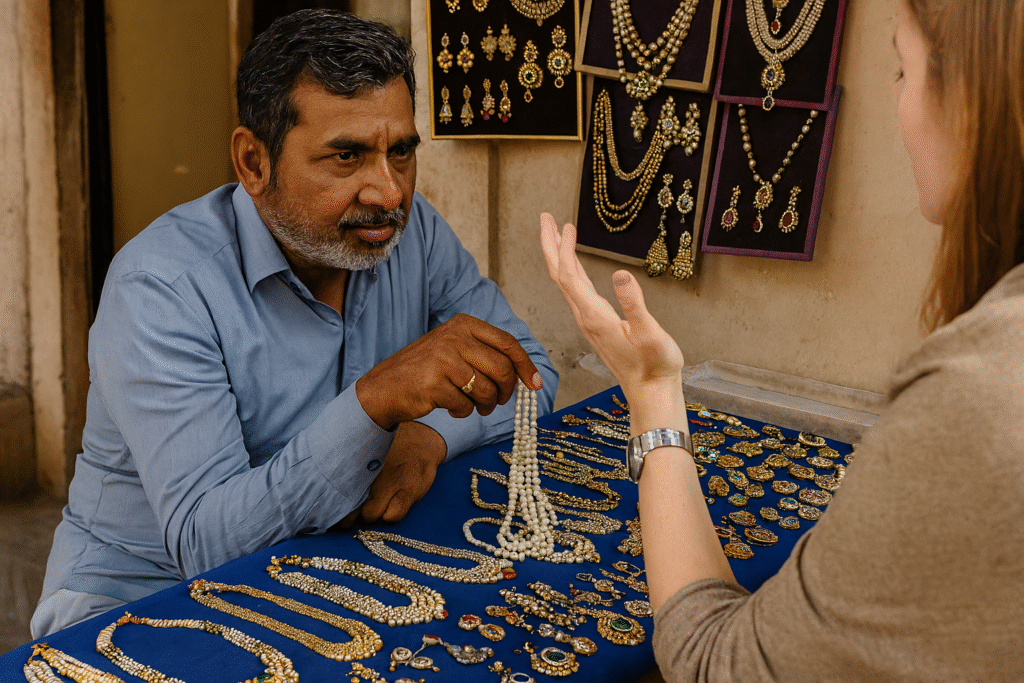Bargaining for jewelry in Jaipur is part of the shopping experience. If you don’t haggle, you risk overpaying. If you haggle too hard, you risk offending the seller. The key is finding a respectful middle ground.
This guide shows you how to negotiate effectively in Jaipur’s famous jewelry bazaars, from Johari Bazaar to Tripolia, while saving money and maintaining goodwill.
Step 1: Know the Market Before You Bargain
Tourists who skip this step often end up paying 20–40% more than locals.
Research average jewelry prices online.
Ask locals what fair rates are for silver, gold, or gemstone jewelry.
👉 “Check average prices online before you enter the market. Also read our guide on Understanding BIS Hallmark: What It Means for Your Jewellery to identify authentic pieces.”
Step 2: Start Low, Stay Polite
- Begin with an offer 30–40% lower than the asking price.
- Keep a friendly tone and smile.
- The key is to show interest while leaving room for the seller to meet you halfway.
👉 If you are considering gold purchases, our post 24K, 22K, 18K: What Every Malayali Gold Buyer Must Know helps you compare purity levels.
Step 3: Use Silence and Walking Away
- If the seller resists, pause before countering.
- Walking away politely often brings a better offer.
- Case study: A traveler in Jaipur saved ₹4,500 on a silver necklace using this tactic.
👉 “Travelers who also want to avoid diamond scams can check Certified Stones Only: How to Avoid Overpaying for Diamonds.
Step 4: Recognize When the Price is Fair
- Some gemstone jewelry has less room for bargaining.
- If the seller stands firm, it often means the item is close to its real value.
- Building rapport now may lead to discounts later.
👉 Learn more about here: Jaipur Tourism Official Website
Q&A
Q: Is bargaining for jewelry in Jaipur rude?
A: No. Sellers expect it, but they value politeness.
Q: What’s a realistic discount?
A: Aim for 20–30%, depending on the material.
Q: How do I know when to stop haggling?
A: If the seller insists, the price is likely fair for the quality.
Quotable Insights
- “The key to bargaining for jewelry in Jaipur is knowing when to smile, when to pause, and when to walk away.”
- “Research shows polite haggling saves tourists up to 30% in Jaipur jewelry markets.”
👉 See our Gold Buying Checklist for Malayalis.
Introduction
This comprehensive Watch Buying Guide answers the most common questions about timepieces.
Whether you’re purchasing your first watch or adding to your collection, these expert insights help you make informed decisions.
From understanding movement types to choosing the right size for your wrist, you’ll find everything needed before making a purchase.
What Types of Watches Should You Consider? – Watch Buying Guide Insights
Understanding the five main categories helps narrow your options:
- Mechanical watches – Use springs and gears. No battery needed.
- Quartz watches – Battery-powered; most accurate.
- Automatic watches – Wind themselves from wrist movement.
- Digital watches – Display time numerically on a screen.
- Smartwatches – Connect to your phone and track fitness data.
Accuracy Expectations – Watch Buying Guide Tips
- Quartz watches – Lose about 15 seconds per month.
- Mechanical watches – Lose 20–40 seconds per day.
- Atomic watches – Lose 1 second every 100 million years.
- Your phone’s clock stays perfectly accurate.
Water Resistance Considerations
Water resistance ratings affect usage scenarios:
- 30m – Handles rain and handwashing
- 50m – Safe for swimming
- 100m – Suitable for snorkeling
- 200m+ – Scuba diving
Replace gaskets every 2–3 years to maintain resistance.
Maintenance Schedule – Watch Buying Guide Advice
- Quartz watches – Battery replacement every 1–3 years.
- Mechanical watches – Full service every 3–5 years.
- Service costs: $200–800 depending on the brand.
Watch for stopping, running fast/slow, or condensation under the crystal.
Pricing Strategy
- Budget watches – Plastic cases, basic movements
- Mid-range watches – Steel cases, reliable mechanisms
- Luxury watches – Precious metals, hand-finished details
Remember: craftsmanship, materials, and brand prestige drive prices.
Sizing Advice
- 6–7 inch wrists – 38–42mm
- 7–8 inch wrists – 40–44mm
- 8+ inch wrists – 42–46mm
Ensure lugs don’t overhang wrist edges.
Complications to Prioritize
- Date display – Useful daily
- GMT hand – Second time zone
- Chronograph – Stopwatch
- Moon phase – Decorative
- Annual calendar – Adjusts month lengths
More complications = more things that can break.
Maintenance Tips
- Clean with a soft cloth
- Avoid extreme temperatures & magnets
- Wind manual watches daily
- Use watch winders for automatics
- Don’t adjust date between 9 PM–3 AM
Investment Potential
- Most watches lose value after purchase
- Only select Rolex, Patek Philippe, Audemars Piguet models appreciate
- Vintage watches from 1960s–70s show strong growth
- Buy watches you enjoy wearing, not solely for investment
Essential Tools
- Spring bar tool
- Case back opener
- Soft polishing cloth
- Watch cushion
- Demagnetizer
Where to Purchase
- Online – Better selection, often cheaper
- Physical stores – Try before buying
- Authorized dealers – Full warranties
- Grey market – Discounts, limited warranty
- Forums/eBay – Vintage pieces, verify authenticity
Learn More:

